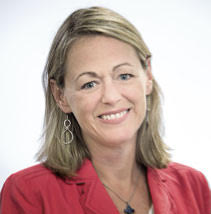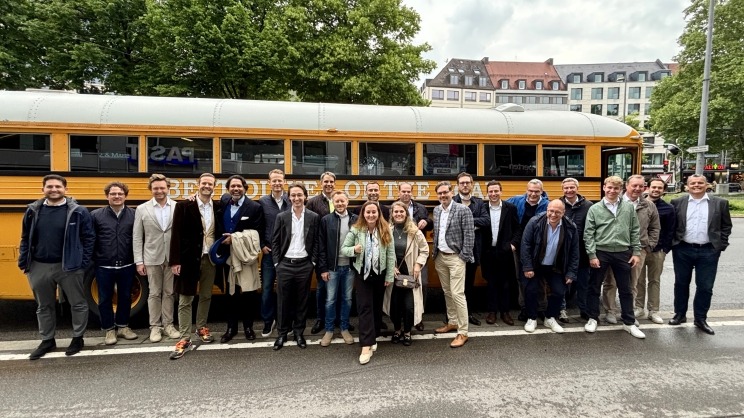Alumni Spotlight: Amelia Fox

Amelia Fox, a former Senior Director with Alvarez & Marsal’s (A&M) Corporate Performance Improvement (CPI) practice from 2005 to 2011, is currently the Chief Strategy Officer and Chief of Staff at Lutheran Services Florida (LSF), a state-wide non-profit organization transforming lives by ensuring safe children, strong families and vibrant communities.
In the following Q&A, Ms. Fox shares what makes a great Chief Strategy Officer and Chief of Staff, how the COVID-19 pandemic impacted the non-profit sector and how strong and talented women inspire her.
You joined A&M several years after you graduated from Yale with an MBA. What ultimately brought you to A&M?
After spending five years consulting with a reputable Big Four organization, I was thrilled to join A&M and seize the opportunity to be the third member in the Atlanta office. The prospect of being a part of a growing organization from the ground up was highly appealing to me, especially since it provided a chance to delve further into management consulting. Working alongside Kevin Redmon and Mark Miller, we had the privilege of expanding the office to a team of thirty-something exceptionally talented individuals. It was truly exhilarating to witness the remarkable growth of our organization, all while having the unwavering support and credibility of A&M, an established player in the market. I felt like I had the best of both worlds—the dynamism of a startup without the uncertainty and risk that comes with it.
Can you share a notable memory you have of your time at A&M?
During a project at a privately held company owned by a private equity (PE) firm, I was given the opportunity to serve as the acting Chief Marketing Officer on an interim basis. As part of the project, we traveled to Chicago to present to the PE firm and bank, and it was during this experience that I learned the importance of sitting with your back to the window to avoid the glare of the sun while presenting. This may seem like a small memory but controlling the meetings is so important and nuances like this do make a difference. (In fact, I used this exact skill a few weeks ago to my advantage!)
Another memorable project I worked on was in Atlanta with a team of five individuals, all of whose names started with the letter A. We playfully dubbed ourselves the "A-Team" and had a blast working together. It was a privilege to collaborate with such talented people and gain valuable experience.
One particularly noteworthy memory I have is presenting on the NYC schools project to Joel Klein, who was the Chancellor of Schools at the time. It was an incredible honor to present at such a senior level, especially to someone overseeing a $15 billion school system.
The experience I gained at A&M was truly invaluable. Even now, not a week goes by without me utilizing something I learned or recalling a decision I made while I was there. It was without a doubt the most rewarding place I've worked in the private sector. The memories, friendships and relationships I formed during my time at A&M are extremely dear to me.
Did you have any mentors from your time at A&M?
I feel incredibly fortunate to have had Kevin Redmon as a close mentor throughout my career. I also worked closely with John Rossman. I acquired a wealth of knowledge from Kevin and John in areas such as strategy and customer relationship management (CRM) and learned how to think more broadly. Sajan George was also instrumental in the NYC schools project, and through working with him, I gained invaluable experience in achieving the next level of preparedness for presentations.
One of the most remarkable aspects of A&M’s company culture was the ability to pick up the phone and seek guidance from anyone in the organization. I felt grateful to have access to daily mentors who were always willing to provide valuable insights, no matter the time or situation.
You’ve transitioned into the non-profit sector as Chief Strategy Officer and Chief of Staff at Lutheran Services Florida. Can you share how you pivoted your career to a non-profit?
My career path evolved in a rather unexpected way. I began my professional journey working in the non-profit sector after college, but once I completed my business degree at Yale, I made the transition to private sector. Although I initially intended to eventually return to the non-profit arena, two decades passed without any deliberate effort to do so. However, a recruiter reached out to me about an opportunity with Lutheran Services Florida, and despite not actively seeking a new role, I was intrigued by the prospect. They were seeking a candidate with my unique blend of experience—someone who had a background in consulting, as well as startup and entrepreneurial ventures, and who understood the importance of technology and strategy. It was a perfect match, and in August 2016, I finally felt that the time had come to close the circle and return to the non-profit world. I relocated to Tampa and joined Lutheran Services Florida, eager to make a difference.
What makes a great Chief Strategy Officer and/or Chief of Staff?
A great Chief Strategy Officer or Chief of Staff is a skilled listener, has the ability to connect the dots and makes complex issues easily digestible. Another vital quality is their willingness to ensure that plans are executed and implemented and become a core part of the company.
To illustrate, I recall walking into the office at LSF recently and witnessing a large training session where one of our VPs was leading the harassment training; she launched the training with our one-page strategy slide which illustrates our mission, vision and values and how core they all are to the company. Her key message was that if we followed the firm’s values that, in and of itself, would ensure a harassment-free environment. This example highlights the importance of having a strong and clear core strategy.
As a Chief of Staff, my role is a little unique. I'm an advisor to the CEO and a problem-solver. This approach necessitates being objective and honest with the CEO, which has been crucial in my role. It's not easy to be truthful, particularly when the CEO's views differ from mine. However, being authentic and honest has always served me well. I actively listen to resistance and feedback to see if there's something I've overlooked or haven't considered. My willingness to adapt and adjust is a vital quality in this role.
What is the most challenging part of your role?
Lutheran Services Florida has experienced significant growth, largely due to our exceptional work that has earned us a reputation for excellence. During the first phase of our growth, we focused on winning bids, and in the second phase, we expanded our programs and markets. However, our biggest challenge now is to think outside the box and explore new lines of business beyond government contracts to diversify our revenue streams. The main obstacle we face is change management, as we strive to shift away from government grants and find new ways to generate revenue. As the change agent in this role, I must disrupt the status quo and operations of our highly effective and successful organization, which is no easy feat.
Tell us about your ability to work under pressure.
Well, it was probably a little better while at A&M and I’ve probably gotten a bit soft. High-end consulting firms teach you how to work well under pressure. I thrive on change and creating big goals for me and my team. I don’t even think of working under pressure, it is just how I operate.
As Chief Strategy Officer and Chief of Staff, what is your role in the strategic planning process? What do you, personally, spend most of your time on at Lutheran Services Florida?
When I first joined LSF in 2016, I spent the initial 3 to 4 years leading the complete overhaul of our strategic plan. This involved redefining our vision and values, developing a new strategy and rolling it out to the organization. A significant part of my role in the strategy was helping LSF mature as an organization – we grew from a 300-person organization in 2010 to a 1200-person one by the time I joined in 2016. Along the way my role expanded beyond strategic planning to also encompass corporate quality assurance, strategic projects, communications and marketing, development, board affairs and the Chief of Staff role.
My time at LSF can be broken down into three phases: the creation and rollout of a traditional strategy, a refreshing of it and navigating through the pandemic during the second phase and raising our brand awareness and diversifying our revenue in the third phase. One of our key strategic issues is diversifying revenue by seeking more foundation and corporate involvement, and donations, which is a major departure from our past. To achieve this, we need to create strategic partnerships and generate more revenue, creating awareness of LSF. From a strategy perspective, our main goal is to generate unrestricted revenue, and I have a development team backing me up to realize this big-picture plan.
Are there any non-profit trends you expect to see for 2023-2024?
The impact of marketplace issues such as inflation and housing costs are becoming increasingly real and affecting our clients. One of the notable trends we're seeing is an increase in demand, which is partly why we're doing well and taking over programs that aren't performing as expected. This demand is particularly high in the mental health and substance abuse spaces, where the demand is outpacing the supply.
Moreover, there is a trend toward an increase in the complexity of cases. For instance, preschool kids are becoming more challenging to serve, and the suicide rates among teenage girls have tripled in the last five years. In our Head Start program, we prepare 0-5-year-olds for preschool, but the impact of poverty is creating more stress on our teachers, and we can't find enough qualified teachers to meet the demand. These statistics illustrate the severity of mental health issues that lead to family crises, and the entire system is struggling to keep up.
Similarly, in the foster care space, the challenges are mounting. Fifteen to 20 years ago, kids in foster care did not come with violent arrests on their records, but this is no longer the case due to the complexities of the system. With human trafficking survivors, abused children and a shortage of families and places to serve them, the foster care system is under immense pressure. These challenges are making it difficult for those working with foster families and children, and the system is suffering in many places.
Lastly, consolidation is a trend in the market, and there is a growing movement towards mergers and acquisitions in the non-profit space, particularly in behavioral health. As the industry moves from "a thousand flowers to a hundred oaks," this trend is likely to continue.
What advice would you give someone who is thinking of moving into a non-profit?
There is an often overlooked aspect of the non-profit world - non-profit is not an industry, rather, it's a sector with multiple business models. We often lump all non-profits together, but I strongly encourage people to learn about the different models of non-profit before diving in.
It's important to understand the type of non-profit model you're considering, as this will be crucial for your success. For instance, my non-profit organization is 100 percent funded by the government with a revenue of $400 million, 98 percent of which is cost reimbursement or passed through funding. Meaning we have no margin to play with and understanding this is crucial for my role as head of strategy. We cannot simply find a need in the market and begin work; we must wait for the government grants to become available (until we are better at diversifying revenue!).
Understanding your passion and what drives you is also essential, as non-profit work typically doesn't pay as well as private sector jobs. However, the flexibility and impact that you can have in the non-profit sector is unparalleled, and if that's what drives you, the pay cut may not matter as much.
For me, I started my career working with homeless children in DC, but I realized that being a case manager or teacher wasn't my true passion. Instead, I found my passion in making the lives easier of front-line workers in social services. It's important to find what drives you and what you're passionate about. The non-profit sector is filled with different models and opportunities, and understanding these will be key to success.
What have you identified as the core differences and similarities between consulting and philanthropy?
One commonality between consulting and non-profit work is that they both involve helping people and solving problems. In consulting, the company or individual has a problem and lacks the capability to solve that internally, whereas non-profits aim to address complex societal issues such as poverty, mental health and immigration. Although the content is different, both fields aim to solve problems. At the management and executive leadership level, the problems being solved are complex in nature. There is a difference in the approach taken to solving the problems: Consulting work generally involves solving the problem and leaving, while non-profit work generally involved finding ways to address the issue and moving forward, even if the entire issue cannot be resolved.
The pace in consulting is intense, as companies pay for quick solutions to often complex problems. In contrast, non-profits must work within funding restrictions and often deal with salary and other limitations. In the non-profit and philanthropic space, the challenge lies in balancing the needs of clients and funders; non-profits serve their clients, but also serve their funders which are usually not the same audiences. These systems have been in place for a long time, and the issues we face in society are daunting, such as extreme poverty and mental health issues. Many organizations in the non-profit sector are trying to address these systemic problems while simultaneously serving the daily needs of individuals and families, which can be challenging. Additionally, unlike consulting, the goal of most non-profits is to reduce the number of clients needing help, ultimately working towards putting the non-profit sector out of business entirely!
I believe that solving the more complex societal issues will require stronger public-private partnerships. Businesses have a stake in the issues – their employees, customers and communities in which they serve are impacted by these issues. We must find new ways of working together to address the systemic issues. One thing I love about being in Tampa is that we are a young and growing city and have the potential to be a model for the nation in addressing these issues. If businesses can leverage their resources and brainpower, and non-profits can contribute their knowledge, there is a unique opportunity to come together and make a real impact. While the skill sets may be similar between consulting and non-profit work, the impact of the problems being solved in the non-profit space is more systemic and wide-reaching.
What are your top three takeaways from working in non-profit?
- Change is a difficult process, especially in an industry with centuries-old traditions like non-profit. In the quasi-governmental model in which I operate, change is slow and requires input from multiple stakeholders, making decision-making complex and challenging. Non-profit organizations must balance the needs of their clients and funders, which can lead to difficulties in implementing changes that might disrupt the delicate balance between the two sides.
- It is crucial to respect the experiences and knowledge of those who have been working in the non-profit field for a long time. These individuals possess invaluable expertise in funding, the complexities of the work and the emotional toll it can take. Failing to consider the downstream effects of decisions can have a severe impact on frontline workers and the clients they serve, unlike in the corporate world where decisions may not have such drastic consequences. Respect for the work they do is of utmost importance.
- Despite the numerous challenges and heartbreaking stories that exist in the non-profit sector, it is essential to stay focused on the positive outcomes and victories. This helps to sustain the motivation needed to tackle these issues every day and become better at it.
How has the COVID-19 pandemic impacted the non-profit sector?
The COVID-19 pandemic had a dual impact on the non-profit sector. On one hand, it caused a surge in demand for services, which placed a strain on resources and staff. On the other hand, it prompted organizations to quickly adapt to new technologies and communication tools. Before the pandemic, video meetings were not common, but now they are a regular occurrence. This forced adaptation has also led to a deeper level of collaboration among non-profit organizations, which was previously hindered by the sector's focus on the front-line work. Although change can be difficult, the pandemic-induced collaboration has led to cross-program collaborations and innovative solutions. Despite the challenging circumstances, this period has helped the non-profit sector mature more rapidly than it would have otherwise.
Your first job was working at Baskin Robbins. What was your biggest takeaway from the role?
Firstly, I learned the importance of customer service. People come for a treat and sometimes the experience can be overwhelming. While working in Columbus, Georgia, which was attached to a military base, soldiers from Central America would come to the mall and struggle to communicate in English. I quickly realized how intimidated they were and that they simply wanted to enjoy their ice cream. This experience taught me how to interact with people from different backgrounds and develop compassion.
Secondly, my attention to detail improved as I decorated cakes, made waffle cones, and handled cleanup. These skills were further developed while working with Sajan on presentations. And I also learned that I did not care to wear brown polyester pants with a striped shirt every day for the rest of my life.
Tampa Bay Business Journal honored you with the 2023 Businesswoman of the Year award. What was that experience like for you?
It was surreal and so much fun. From the moment I started the application process and had to reflect on my life and career, it felt intimate and thought-provoking. Seeing my name on the final list and attending the fantastic event was a validation of some of the things I've been striving to do, such as mentoring women and making a positive impact in my work. It was also great for LSF's visibility, as we had two tables at the event. Overall, it was a humbling and exhilarating experience that I won't forget anytime soon.
What drives you to succeed?
Improving things has been a lifelong passion of mine, starting from childhood. Whatever I’m doing, I want to do it a little better, a little more efficiently, and help people start and stop what they need to do in order to get where they need to go. This has been a consistent theme throughout my life.
I tend to become frustrated with excessive bureaucracy and have always believed that the status quo is unacceptable. Being stagnant can lead to the development of bad habits and inefficient processes, which ultimately harms our customers, clients and the people we serve. This, in turn, negatively impacts our bottom line.
Both my parents were hardworking individuals, with my father holding multiple jobs and my mother returning to college while I was in elementary school. Witnessing their strong work ethic and innovative problem-solving skills instilled in me the desire to be innovative and find new solutions to problems.
Using 5 adjectives or short phrases, describe yourself.
Eager. Inquisitive. Authentic. Caring. Innovative.
How do you spend your time outside of work?
I am a mother to an amazing teenage boy who is just finishing eighth grade. I love being his mom and watching him grow. When I adopted him, we had the opportunity to travel to Kazakhstan for two months, a memory that I will always cherish. We play golf and go fishing and boating together. I’ve found I really like fishing and had an incredible experience kayak fishing for redfish with my partner (shout out to David Riviere – I finally understand your passion for redfish!). I am passionate about cooking and enjoy experimenting with various ethnic cuisines, including tamales, dumplings, sushi, manti and Plov, a traditional Kazakhstani dish.
Who inspires you?
The strong and talented women I work with are my biggest source of inspiration. I have been fortunate to have friends from college who have gone on to accomplish amazing things, as well as colleagues from graduate school and my first job, who have supported me throughout various stages of my life, and the women I worked with at A&M, like Cyndi Joiner. These women drive me to do better, and I feel grateful to both give and receive support from them.
You’re involved in several charities, such as the J127 Ranch, Bay Area Bridge Builders and Orphan Aid. How did you get involved with these charities? And what advice would you give someone who is looking to join a board?
I try to stay involved with a few important charities. One of them is Bay Area Bridge Builders, which is a networking group that my colleague and I started. It connects businesses with non-profits and philanthropic opportunities in the Tampa Bay area. The goal is to provide a forum for people who want to give back to the community. Another charity I support is J127 Ranch, which is based in Kazakhstan. I met them through the Kazapoolaza community, which supports families who have adopted children from Kazakahstan. J127 Ranch serves children and mothers in crisis, providing them with education, healthcare and nutrition. Supporting them helps me stay connected to my son's home country. Lastly, I support Orphan Aid through their Bake-in-Time program, where they sell bakery items; 100 percent of the profits go to orphanages around the world.
When it comes to joining a board, I recommend volunteering with the organization first and getting to know the governance model and board members. It's important to be committed and bring value to the organization. Non-profits rely on boards to provide leadership and ask tough questions to keep the organization moving forward. If you’re doing it to check a box, I’d check a box somewhere else.
Originally, when you moved to Tampa, you thought it was a temporary move. Now that it’s proved to be a more permanent one, can you share with us what life is like in Tampa?
When I first arrived, I only planned to stay for three years before returning to Atlanta, but something about Tampa captured my heart. The city is alive with energy and growth, attracting a vibrant and friendly community of people. I have met countless individuals who have offered me their help and support. The entrepreneurial spirit is strong, with numerous startups and mid-size companies thriving in the area. Plus, being just thirty minutes from the beach and able to easily get out on the water is truly amazing. The sound of the water and the salty breeze is something special.




